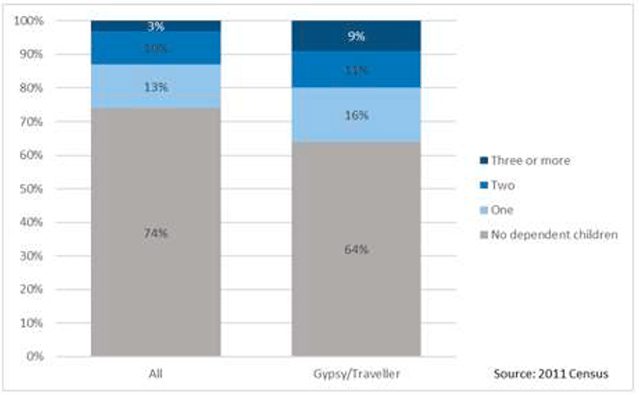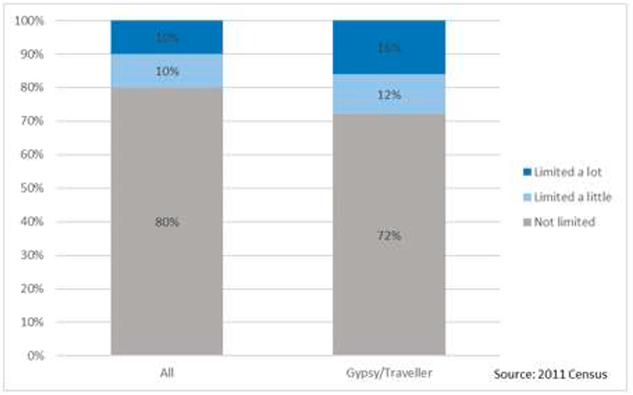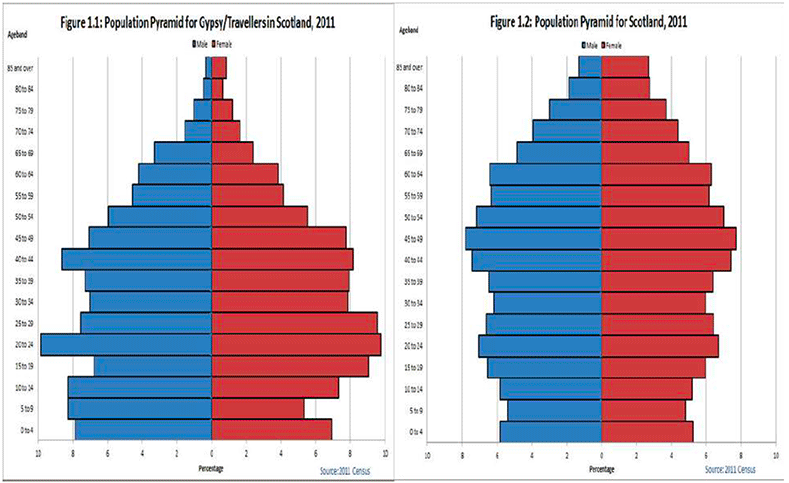Gypsy/Travellers - accommodation needs: evidence review
Overview of the evidence about the accommodation needs of Gypsy/Travellers in Scotland, drawing on both academic and grey literature. It discusses current provision, accommodation needs and aspirations, and identifies key areas which could be explored through further research.
3. Background
3.1 Gypsy/Travellers in Scotland
Gypsy/Travellers are recognised as a distinct ethnic group by the Scottish Government. The population has a long and diverse history in Scotland and includes a range of communities who regard nomadism as an integral part of their cultural identity. There is a large body of evidence, both in Scotland and the UK, which positions lack of access to culturally appropriate housing as a major contributory factor in the poor health, educational and societal outcomes experienced by Gypsy/Travellers (EOC 2013; Equality and Human Rights (EHRC) 2015; Shelter 2008; Parry et al., 2004). There is a high degree of diversity amongst Gypsy/Traveller groups in Scotland, with different groups speaking a variety of languages, such as Cant, Gammon or Romani[4], and holding to distinct customs and traditions. Some Gypsy/Travellers travel all year round, while others maintain a permanent site or live in settled housing. Crucially, travelling is not only the physical act of moving but is considered a way of looking at the world, which is evident in every aspect of their lives (Shubin & Swanson 2010). The Scottish Government recognises that Gypsy/Travellers are a particularly marginalised population and discrimination continues to be a part of everyday life for many (Scottish Government 2019). This is reflected in the extent to which Gypsy/Travellers have been a focus of Scottish Government policy development in recent years – across planning, housing and equalities.
3.2 Policy Context
In 2013, the Equal Opportunities Committee published their report Where Gypsy/Travellers Live[5], which examined the issues around the quality and quantity of Gypsy/Traveller sites. The report highlighted the poor quality of many sites across Scotland, a lack of transit and stopping places and the fact that high levels of discrimination are faced by the community. The report made a number of recommendations aimed at improving site provision, local strategic planning and strengthening leadership at all levels, with community participation.
The Scottish Government's Race Equality Action Plan 2017-2021, sets out key actions for the current parliamentary session to drive positive change for minority ethnic groups in Scotland. The action plan reinforces the findings of the EOC 2013 report and includes a specific section on Gypsy/Travellers, recognising that outcomes remain poor across all indicators. It established a Ministerial Working Group, chaired by the Cabinet Secretary for Communities, Social Security and Equalities, with the aim of determining priorities for action and driving forward the changes required on a range of issues, including accommodation (housing and planning), employment, health and education (Scottish Government 2017a).
The work of the Ministerial Working Group resulted in the Scottish Government and COSLA publishing the joint action plan Improving the Lives of Scotland's Gypsy/Travellers 2019-2021[6]. The plan sets out agreed actions to be taken forward across local and national government to ensure that Gypsy/Travellers are treated fairly, have positive experiences of public services, and can access all of their rights and entitlements. Progress on these actions was set to be reviewed on a six monthly basis by Ministers and community members.
A short life working group and a subsequent stakeholder group on Gypsy/Traveller accommodation convened in 2019, are currently taking forward the accommodation actions from the action plan, including further data collection, with the involvement of members of the Gypsy/Traveller community (Scottish Government 2019a).
In the 2018-19 Programme for Government, the Scottish Government made a commitment to plan together with stakeholders how homes and communities should look and feel in 2040 and how to get there. The draft vision, which has now been consulted on[7], includes the provision of 'culturally appropriate sites and accommodation for Gypsy/Travellers that meets their needs and aspirations' (Scottish Government 2019c). Culturally appropriate accommodation denotes the provision of accommodation such as sites and stopping places which allow Gypsy/Travellers to maintain their travelling lifestyle and fulfil their cultural needs.
In April 2020, the Scottish Government published a framework to help local authorities support Gypsy/Traveller communities living on public and private sites, and on unauthorised encampments during the Covid-19 pandemic. A revised framework was published in June 2020[8]. The revised framework recognises that there is an opportunity to build on the positive work done by Local Authorities to support people living on public sector sites and the roadside during the lockdown and to continue to provide for the needs of Gypsy/Travellers, including to support the right to travel, and progress the objectives of the Gypsy/Traveller action plan.
3.3 Population
Currently, there is limited data on the size of the Gypsy/Traveller population in Scotland and what does exist is either dated or incomplete. The 2011 Census is the most current and comprehensive source of data available on the size and profile of the population in Scotland (see Annex 3). The 2011 Census was also the first to include an option for Gypsy/Travellers in the ethnicity category, enabling the collection of baseline data for the first time. In 2011, 4,212 people identified themselves as White: Gypsy/Traveller, however, this data is generally agreed to be an underestimate of the population. This can be attributed to the reluctance of individuals to identify as Gypsy/Traveller for fear of discrimination and the challenges that exist in accessing the population living on sites and at the roadside for data collection purposes (Craigforth & Engage Scotland 2018). Organisations that work with Gypsy/Travellers believe Scotland's community is much larger, comprising somewhere between 15,000 to 20,000 individuals (EHRC 2013).
In the last official count of Gypsy/Travellers, commissioned by the Scottish Government in 2009, over 2,000 individuals were living on local authority/RSL sites, private sites and unauthorised encampments in Scotland (Scottish Government 2009). However, concerns around the accuracy and robustness of count data have been raised, specifically in relation to undercounting and inconsistencies in how the count is conducted across local authority areas. Insufficient capacity and knowledge amongst designated officers has also been noted as an issue (Scottish Government 2010).The review of the count in 2010 estimated that it may only record between a third and a half of the total Gypsy/Traveller population (Scottish Government 2010). More recent data from the Scottish Housing Regulator (SHR), found that there were around 2,000 Gypsy/Travellers living on RSL sites in 2018 alone. Taken together, these figures suggest that current administrative sources (such as data from the Census and last official count) when compared to estimates from the third sector, likely underestimate the true size of the Gypsy/Traveller population in Scotland. Most of the available evidence also focuses solely on those living on official sites and encampments, meaning there is likely to be a largely invisible population in settled housing that is unrecorded. As one study notes, the inaccuracy of information is therefore a key issue (Clydeplan 2015b).
3.4 Household composition and characteristics
Analysis of the 2011 Census data shows that members of the Gypsy/Traveller community differ from the wider community in a number of key ways. For example, Gypsy/Travellers are twice as likely as those in the wider population to live in a lone parent household and are much more likely to have dependent children, (36%) compared to the rest of the population (26%). Gypsy/Traveller households are also three times as likely to contain three or more dependent children.

Source: National Records of Scotland, 2011 Census
The Census also collected data on the health of Gypsy/Travellers, which shows that they are more likely than the general population to have a limiting long-term health problem or disability; 28% compared to 20%.

Source: National Records of Scotland, 2011 Census
The Census indicates that the age profile of Gypsy/Travellers was much younger than the population as a whole. Only 28% of Gypsy/Travellers were aged 45 or over compared to 44% of the population as a whole, and only 4% were aged 70 or over compared to 12% of the population as a whole. The gender split amongst Gypsy/Travellers was largely reflective of the population as a whole, with 49% of Gypsy/Travellers identifying as male and 51% as female (Scottish Government 2015a).

Source: Scottish Government (2015a). Gypsy/Travellers in Scotland: A Comprehensive Analysis of the 2011 Census
3.5 Discrimination against Gypsy/Travellers in Scotland
There is a large body of evidence that the Gypsy/Traveller population continues to face high levels of discrimination and harassment in Scotland (Craigforth & Engage Scotland 2018; Grampian Regional Equality Council (GREC) 2017; EHRC 2015; Scottish Government 2015b). Data from the Scottish Social Attitudes[9] survey shows that Gypsy/Travellers, as a group, are the subjects of 'fairly widespread discriminatory attitudes'. For example, respondents indicated that they would be unhappy if a close relative married someone who was a Gypsy/Traveller (31%) and a third (34%) viewed them as being unsuitable to be a primary teacher (Scottish Government 2015b).
Research undertaken by Amnesty International on the media coverage of Gypsy/Travellers in Scotland suggests that these negative attitudes may, in part, be reinforced by the media. The study found that the Gypsy/Traveller community received disproportionate coverage across media platforms and that nearly half (48%) of this coverage was negative, while positive coverage accounted for 28% (Amnesty International 2012a). In a study carried out in England, such negative coverage was found to put off those Gypsy/Travellers who were literate[10] from reading the media, with the result that they were less well-informed (Home & Greenfields, 2006). These findings were recognised in a resource produced by the EHRC, which sought to assist journalists in presenting informed and balanced coverage of Gypsy/Travellers (EHRC 2013).
Some evidence suggests that a lack of appropriate housing often forms a key part of the discrimination that Gypsy/Travellers face. This is due to the fact that inadequate site provision often leads to an increase in unauthorised encampments in an area, putting Gypsy/Traveller communities into conflict with the settled population (GREC 2017; EHRC 2015; EOC 2013). For example, one respondent to the Committee inquiry stated that they had found local communities to be supportive of Gypsy/Travellers until they stopped in their area (EOC 2013). Research carried out by the EHRC concluded that addressing the accommodation needs of Gypsy/Traveller communities is the shortest and quickest route to ensuring positive outcomes and good relations (EHRC 2015).
Contact
Email: socialresearch@gov.scot
There is a problem
Thanks for your feedback